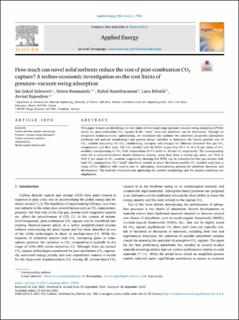How much can novel solid sorbents reduce the cost of post-combustion CO2 capture? A techno-economic investigation on the cost limits of pressure–vacuum swing adsorption
| dc.contributor.author | Subraveti, Sai Gokul | |
| dc.contributor.author | Roussanaly, Simon | |
| dc.contributor.author | Anantharaman, Rahul | |
| dc.contributor.author | Riboldi, Luca | |
| dc.contributor.author | Rajendran, Arvind | |
| dc.date.accessioned | 2022-03-11T11:18:08Z | |
| dc.date.available | 2022-03-11T11:18:08Z | |
| dc.date.created | 2021-10-25T08:40:35Z | |
| dc.date.issued | 2021 | |
| dc.identifier.issn | 0306-2619 | |
| dc.identifier.uri | https://hdl.handle.net/11250/2984597 | |
| dc.description.abstract | This paper focuses on identifying the cost limits of two single-stage pressure–vacuum swing adsorption (PVSA) cycles for post-combustion CO2 capture if the ‘‘ideal’’ zero-cost adsorbent can be discovered. Through an integrated techno-economic optimisation, we simultaneously optimise the adsorbent properties (adsorption isotherms and particle morphology) and process design variables to determine the lowest possible cost of CO2 avoided (excluding the CO2 conditioning, transport and storage) for different industrial flue gas CO2 compositions and flow rates. The CO2 avoided cost for PVSA ranges from 87.1 to 10.4 e per tonne of CO2 avoided, corresponding to CO2 feed compositions of 3.5 mol% to 30 mol %, respectively. The corresponding costs for a monoethanolamine based absorption process, using heat from a natural gas plant, are 76.8 to 54.8 e per tonne of CO2 avoided, respectively showing that PVSA can be attractive for flue gas streams with high CO2 compositions. The ‘‘ideal’’ adsorbents needed to attain the lowest possible CO2 avoided costs have a range of CO2 affinities with close to zero N2 adsorption, demonstrating promise for adsorbent discovery and development. The need for simultaneously optimising the particle morphology and the process conditions are emphasised. | en_US |
| dc.language.iso | eng | en_US |
| dc.publisher | Elsevier | en_US |
| dc.title | How much can novel solid sorbents reduce the cost of post-combustion CO2 capture? A techno-economic investigation on the cost limits of pressure–vacuum swing adsorption | en_US |
| dc.type | Peer reviewed | en_US |
| dc.type | Journal article | en_US |
| dc.description.version | publishedVersion | en_US |
| dc.rights.holder | The Authors | en_US |
| dc.source.volume | 306 | en_US |
| dc.source.journal | Applied Energy | en_US |
| dc.identifier.doi | 10.1016/j.apenergy.2021.117955 | |
| dc.identifier.cristin | 1948099 | |
| dc.relation.project | Norges forskningsråd: 257579 | en_US |
| dc.source.articlenumber | 117955 | en_US |
| cristin.ispublished | true | |
| cristin.fulltext | original | |
| cristin.qualitycode | 1 |
Tilhørende fil(er)
Denne innførselen finnes i følgende samling(er)
-
Publikasjoner fra CRIStin - SINTEF Energi [1614]
-
SINTEF Energi [1730]
